Activity-DEPendent Transposition
- PMID: 28219904
- PMCID: PMC5331197
- DOI: 10.15252/embr.201643797
Activity-DEPendent Transposition
Abstract
The authors propose a novel mechanism, termed Activity‐
Figures

References
-
- Muotri AR, Chu VT, Marchetto MC et al (2005) Nature 435: 903–910 - PubMed
Publication types
MeSH terms
Substances
LinkOut - more resources
Full Text Sources
Other Literature Sources
Medical

